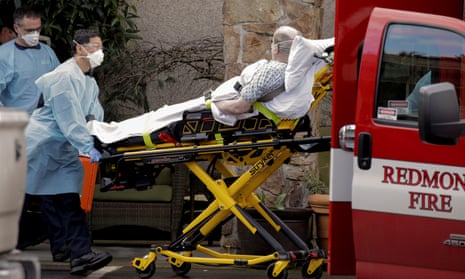Tensions over how to contain the fast-spreading coronavirus escalated Tuesday in the United States as the death toll climbed to nine and lawmakers expressed doubts about the government’s ability to ramp up testing fast enough to deal with the crisis.
All of the deaths have occurred in Washington state, and most were residents of a nursing home in suburban Seattle. The surge is raising concerns about the dangers of the coronavirus to the elderly and immunocompromised. The number of cases in the US overall climbed past 100 scattered across at least 14 states, with 27 in Washington.
Meanwhile, in New York state, a second coronavirus case has been confirmed in a 50-year-old man with an underlying respiratory illness. He is hospitalized in serious condition. According to state health officials, the man is an attorney who lives in Westchester county north of New York City and works in Manhattan.
New York’s governor, Andrew Cuomo, told reporters at a press conference on Tuesday that the patient had not traveled to countries considered the epicenter of the outbreak but had visited Miami recently.
The confirmed diagnosis marks the first apparent community-spread case regionally. Because the patient is not believed to have come into contact with other infected people, health officials said it raises concerns that the pathogen is spreading locally.
“With the results confirmed within a number of hours, we were immediately able to take next steps to stop the spread of this virus,” said New York City’s mayor, Bill de Blasio. “We have said from the beginning that it is likely we will see more positive cases of the coronavirus.”
The patient had primarily been with his family in Westchester. Health officials are testing friends, relatives and anyone who may have come in contact with him for risk.
News of the second case spread as an Orthodox Jewish school in New York City canceled classes on Tuesday to allow for precautionary measures after a suspected case of coronavirus turned up within its community.
Health officials cautioned, however, that a second confirmed case should not be a cause for alarm, reiterating that they had expected that the disease would be found in multiple locations around the state and that it would be likely to spread.
“We want New Yorkers to go about their everyday lives, use the subway, take the bus, etc,” city health commissioner Dr Oxiris Barbot said, adding that the coronavirus “is not an illness that can be easily spread through casual contact”.
Governor Cuomo disclosed the second case after the SAR Academy and high school, in the Riverdale section of the Bronx borough, said it was in touch with the city’s department of health and following its guidelines.
New York had previously reported one confirmed case, in Manhattan, on Sunday. The 39-year-old woman had recently returned from visiting Iran – one of the virus’s global centers. Her husband is also undergoing tests and his results are expected to come back positive.
The US surgeon general urged Americans to remain calm after about 100 coronavirus cases had been confirmed in 15 states, with New Hampshire and Georgia being the most recent. “We should be cautious and take appropriate measures to prepare and protect ourselves, but we should not be afraid,” the surgeon general, Jerome Adams, said.
In a phone conference on Tuesday, the CDC confirmed 60 positive or presumed-positive cases of the coronavirus nationwide and expressed growing concerns for vulnerable populations throughout the US.
Research into cases worldwide indicated serious illness occurs in 16% of coronavirus cases, particularly in older people and those with underlying health conditions.
“What is happening now in the US may be the beginning of what is happening abroad,” said Nancy Messonnier, director for the National Center for Immunization and Respiratory Diseases, in an opening statement.
The director faced tough questioning from reporters over criticism of the department’s handling of the health crisis, including the initial limited availability of diagnostic test kits and strict qualifications for screening.
Many critics say these measures may have contributed to the virus lying dormant in places like the Seattle suburbs for weeks. Reporters also pressed the director over the CDC’s cooperation with state and local health officials to provide updated infection numbers.
While Messonnier noted that the department “of course will be aggregating data on a daily basis”, she also acknowledged the CDC’s numbers “may be a little delayed” because of the volume of “testing kits going out”.
The CDC update came as the Wall Street Journal first reported that Trump administration officials are weighing using national disaster program dollars to fund hospital care for uninsured patients with the coronavirus.
Under the National Disaster Medical System reimbursement program, the federal government reimburses hospitals and medical facilities by paying them higher rates than Medicare for treating at-risk patients.
There are an estimated 27 million Americans without health coverage.
Dr Robert Kadlec, the US health department’s assistant secretary for preparedness and response, acknowledged discussion of the use of disaster funds in a hearing before the Senate committee on health, education, labor, and pensions on Tuesday.
He added that, in a major pandemic, the US would need 3.5bn N95 respirator masks to fight the virus.
“We have about 35 million,” he said.
The World Health Organization has confirmed nearly 90,000 cases, the vast majority in China, and more than 3,000 deaths.
Coronavirus, or Covid-19, is a respiratory illness with symptoms similar to flu and is thought to spread mainly via respiratory droplets among “close contacts” – such as coming directly into contact with the droplets or certain other bodily fluids.
The virus can also be spread from being within about 6ft of a patient for a prolonged period, according to the CDC.
It is characterized by fever and coughing and, in serious cases, shortness of breath or pneumonia. Most who contract it recover but it can develop into pneumonia-like symptoms, with the elderly and those with health problems at particular risk.
